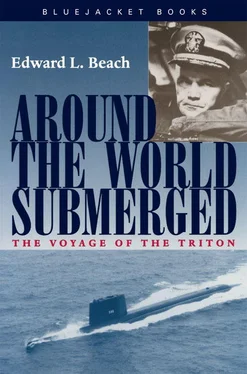“Old Sal” reached the United States on December 22, 1957. On arrival, Beckhaus received a medal for heroism; and I was home for Christmas. In the mail were orders detaching me from command of Salamonie and directing me to report to the “Director of Naval Reactors, Atomic Energy Commission, Washington, D.C., for duty under instruction in nuclear power.”
1

If there is anything about the redoubtable Vice-Admiral Rick-over which is predictable, it must be his insistence upon the most thorough training, the most complete familiarity with operational and design procedures, the most meticulously careful engineering practice by the designers, builders, and personnel who operate nuclear machinery. A magnificent record of trouble-free operation of his nuclear power plants is one of the results. It is attained by vigilance on the part of all personnel involved—and of all of them, the most vigilant is Vice-Admiral Rickover himself.
In the case of the Triton, by the time the ship first put to sea in September, 1959, some of her crew had been training for a period of two years or more. Officers and enlisted men alike had to go through a rigorous program, carefully tailored for the needs of each individual case.
Executive Officer Will Adams and I, for instance, received what we later decided was the most strenuous and yet the most satisfying period of training, testing, and qualification either of us had ever experienced. Before we were finished, we had mapped out the entire power plant of the Nautilus prototype near Arco, Idaho, and had done the same thing for Triton ’s own prototype, more recently completed at West Milton, New York. We spent eight weeks in Idaho, during the hot summer of 1958, studying from sixteen to eighteen hours a day, seven days a week, Sundays and holidays included. At the conclusion of this period Adams and I took a comprehensive written examination which, in my case at least, took fourteen hours to complete (Will, to my dismay, walked out of the examination room two hours before me). At West Milton, our eight weeks of training was split up, partly because the prototype had barely begun to operate; but here, too, we made the same slow careful checkout of all systems.
By the time we arrived at the Electric Boat Division of the General Dynamics Corporation, in Groton, Connecticut, to participate in the launching of our new ship, which took place on August 19, 1958, we had received the best possible training in the techniques of operating her highly complicated machinery and handling all conceivable functions and malfunctions.
As time went on, and we came to know them intimately, Adams and I developed a deep admiration for the designers of our fantastic power plant, and it is probably proper at this point to state that Lieutenant Commander David Leighton, USN, stands second only to Admiral Rickover in our appreciation of the job done. We also developed a strong regard for the officers and men of Triton ’s crew, who had already spent so many days learning how to man her.
Already, she had created difficulties because of her great size. Among the problems faced by the builders was that her huge bow blocked the space reserved for the railroad which ran just forward of the building ways. This railroad was needed to haul regular loads of ship-building supplies which were needed in the Yard. It had to be kept operating. The problem was solved by cutting away a part of the lower section of Triton ’s bow to clear the trains, and replacing it barely a few days before the launching.
At the other end of the ship, her stern projected so far out over the Thames River that efficient construction was not possible. Therefore, to the considerable consternation of the people on the New London side of the river, who could see only a great unfinished cavern where Triton ’s stern should have been, her last fifty-foot section was constructed on the adjoining ways. After the stern was built, a pair of tremendous overhead cranes hauled it into its proper place. (Before this was done, Electric Boat was many times playfully reminded of the importance of finishing a ship before launching her.)
One segment of the ship could not, however, be installed before the launching ceremony. Triton stood on the ways about seven stories above the ground, too high to slide under the giant overhead cranes of the building ways; the top twelve feet of her sail (the great vertical structure carrying her periscopes and retractable masts) had to be cut off and reinstalled after launching.
The outstanding feature of Triton, responsible for her unprecedented length and displacement, was that for the first time not one but two reactors were included in a nuclear submarine. The forward reactor would supply steam to the forward engine room and drive the starboard propeller; number two reactor would supply steam to the after engine room and drive the port propeller. The two plants, identical in design, were entirely independent and separate, but could, of course, be cross-connected if necessary. Designed for high speed on the surface as well as beneath it, she had a long slender hull in contrast to the short, fat shape best suited to underwater speed alone. Triton was 447½ feet long, more than a hundred feet longer than any previous US submarine, almost as long as Dad’s lost Memphis of some forty years before. But where the Memphis had over sixty feet of beam, Triton had only thirty-seven. Her surface displacement was approximately six thousand tons; submerged, she would displace eight thousand tons, about twice as much as any other submarine.
As Triton stood ready for launching, her mammoth hull equaled in size a light cruiser of World War II. Inside, her reactors and machinery were of the most sophisticated design and development yet achieved by any nuclear power plant.
Her underwater body showed a dull olive green when the scaffolding was cleared and she stood in solitaire on two ribbons of shiny tan-colored wax. Around her towered the black skeletonlike framework of the overhead cranes, and crowning her entire length was a double-strength steel superstructure, painted a brilliant orange. Perched on top of this was the bulky lower section of the sail, truncated by removal of the upper half but still seeming high enough to strike the cranes above.
Launching a ship is an important point in her construction program. Contrary to the impression some people may have, a ship is far from fully constructed when she is launched. With the exception of small pleasure craft, no ship can be completed before she is floating in the water, for even the most careful calculations cannot foretell the precise manner in which the hull will take up the stresses of being waterborne. Certain extremely precise technical work, such as final boring of the propeller-shaft tubes and lining up turbines and reduction gears on their foundations, cannot be accomplished until after the ship is afloat. Otherwise, a tiny deflection of a sixteenth or a thirty-second of an inch—easily possible in a hull the length of ours—might throw the reduction gears or propeller shafting out of line.
On the nineteenth of August, 1958, a warm New England summer day, thirty-five thousand guests had come to the Electric Boat Division to see Triton launched—the biggest crowd ever assembled at EB, so the papers said, for the biggest submarine ever built. It was a great day for Triton, for Electric Boat, for Triton ’s crew, and for me.
About half our crew were aboard for the ceremony, in close formation on the forecastle, resplendent in their dress-white uniforms. Also in whites, I waited above them on a makeshift platform provided at the half-level of the decapitated bridge. A few planks had been nailed together to make a platform near the forward end, and this was where I stood. Unfortunately, it was so low I could barely see over the side, but I found that by standing on top of the ship’s whistle, built into the forward section of the sail, and holding onto a girder at its edge, I was able to get a pretty good view of the ceremonies. I could not, however, see the launching platform or the festivities going on there beneath the Triton ’s bow.
Читать дальше













